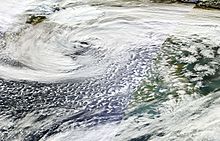| First storm formed | 12 November 2015 |
|---|---|
| Last storm dissipated | 28 March 2016 |
| Strongest storm | Frank — 928 hPa (27.4 inHg) |
| Strongest wind gust | 106 mph (171 km/h; 92 kn) The Needles Old Battery, United Kingdom. (28 March) |
| Total storms | 11 |
| Total damage | ≥ £3.657 billion (≥ €4.047 billion) |
| Total fatalities | 7 |
| Strongest storm is determined by lowest pressure and maximum recorded non-mountainous wind gust is also included for reference. ← 2013–2014 (Europe) 2016–17 → | |
The 2015–16 UK and Ireland windstorm season was the first instance of the United Kingdom's Met Office and Ireland's Met Éireann naming extratropical cyclones. The season started on 10 November with the naming of Storm Abigail and ended on 28 March with the dissipation of Storm Katie. With a total of eleven named storms, the 2015–16 season is the most active to date.
Storms are named when they are forecast to cause hazards due to high winds by either organisation. The season is most notable for the amount of rainfall which fell over the UK and Ireland, causing the 2015–16 Great Britain and Ireland floods; most of which is attributed to Storms Desmond, Eva and Frank. Its strongest low-altitude gusts to hit land came from storms Gertrude and Katie – on 29 January, Gertrude's 105 mph (169 km/h; 91 kn) at Lerwick, Shetland Islands, Scotland and Katie's 106 mph (171 km/h; 92 kn) on 28 March at The Needles Old Battery, the narrow western tip of the Isle of Wight, England.
The season preceded the 2016–17 UK and Ireland windstorm season.
Background
Main article: Winter storm naming in the United Kingdom and Ireland
Earlier in 2015, the Met Office and Met Éireann announced a pilot project to name wind storms and asked the public for suggestions. The full list of names for 2015, common to both the UK and Ireland, chosen for future selection are:
- Abigail (12–13 November 2015)
- Barney (17–18 November 2015)
- Clodagh (29 November 2015)
- Desmond (4–6 December 2015)
- Eva (23–24 December 2015)
- Frank (29–30 December 2015)
- Gertrude (29 January 2016)
- Henry (1–2 February 2016)
- Imogen (7–8 February 2016)
- Jake (2 March 2016)
- Katie (28 March 2016)
- Lawrence (unused)
- Mary (unused)
- Nigel (unused)
- Orla (unused)
- Phil (unused)
- Rhonda (unused)
- Steve (unused)
- Tegan (unused)
- Vernon (unused)
- Wendy (unused)
A storm will be named when it is deemed able to have a "substantial" impact on the UK or Ireland. They will be taken from the list, in alphabetical order, alternating between male and female names – the same naming convention used by the United States for tropical cyclones. In the case of storms resulting from ex-tropical storms and hurricanes, the original name allocated by the US National Hurricane Center will be used. Met Éireann name any storm which triggers a status orange or red weather warning for wind. The basis for such as outlined on their weather warning service are mean wind speeds in excess of 80 km/h (50 mph; 43 kn) or gusts over 130 km/h (81 mph; 70 kn). Similarly, the Met Office name storms that have the potential to cause medium (orange) or high (red) impacts to the UK. It describes the wind strength relative to observations such as "falling trees or tiles and other items like garden furniture being blown around."
Seasonal summary
Comparison of strongest gusts associated with each storm in the UK and Ireland.

Storms
Storm Abigail
| Abigail | |
|---|---|
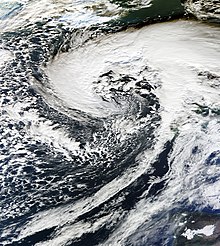 MODIS image of Abigail on 12 November 2015 MODIS image of Abigail on 12 November 2015 | |
 | |
| Date of impact | 12–13 November |
| Maximum wind gust | 84 mph (135 km/h; 73 kn) (South Uist, Outer Hebrides) |
| Lowest pressure | 964 hPa (28.5 inHg) |
| Fatalities | 0 |
| Power outages | 20,000 |
Abigail was the first storm to be officially named (jointly) by the Met Office and Met Éireann on 10 November 2015. The Free University of Berlin named the cyclone Frank. A Met Office yellow warning for wind was issues to all of Scotland on 11 November; with amber warnings for the Western Isles, north west Highlands, parts of Argyll and Orkney. Initial forecasts on 12 November from a Chief Meteorologist at the Met Office warned of wind gusts widely reaching 60 and 80 to 90 mph (97 and 129 to 145 km/h; 52 and 70 to 78 kn) in exposed locations. The Scottish Environment Protection Agency also warned of the risk of flooding due to the storm, as the weather system was anticipated to create a storm surge along the south-west and west coast, due to coincidence with a high tide.
Abigail brought high winds, rain, lightning, and wintry showers across the north and northwest of Scotland. On 12 November, local ferries were affected by bad weather with many services cancelled. It was announced that every school in the Western Isles and Shetland were to be closed to pupils on 13 November. The storm left more than 20,000 homes without power, according to energy company SSE.
Storm Barney
| Barney | |
|---|---|
 MODIS image of Barney on 17 November 2015 MODIS image of Barney on 17 November 2015 | |
 | |
| Date of impact | 17–18 November |
| Maximum wind gust | 85 mph (137 km/h; 74 kn) (Aberdaron, Gwynedd) |
| Lowest pressure | 980 hPa (29 inHg) |
| Fatalities | 0 |
| Power outages | 26,000 |
| Damage | ≥ £179 million (≥ €198 million) |
A yellow warning for wind was issued by the Met Office for Wales, along with southern, central and eastern England, with gusts of 70 to 80 mph (110 to 130 km/h; 61 to 70 kn) expected on 17 November.
It affected Ireland, Wales, southern and eastern England and the Midlands, where thousands of homes lost power and rail services were disrupted. The storm was named Heini by the Free University of Berlin adopt-a-vortex scheme.
Storm Clodagh
| Clodagh | |
|---|---|
 MODIS image of Clodagh on 30 November MODIS image of Clodagh on 30 November | |
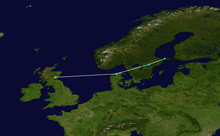 | |
| Date of impact | 29 November |
| Maximum wind gust | 97 mph (156 km/h; 84 kn) (High Bradfield, South Yorkshire) |
| Lowest pressure | 968 hPa (28.6 inHg) |
| Fatalities | 0 |
| Power outages | 16,000 |
| Damage | ≥ £8 million (≥ €9 million) |
The Met Office issued a statement on 26 November saying that despite a prediction of windy weather in the coming days, the weather system was unlikely to become a named storm. On 28 November, Met Éireann upgraded its warnings and named the storm Clodagh. The Danish Meteorological Institute christened the low as Gorm on the same evening. The Free University of Berlin named the low Nils II.
In the UK and Ireland, Clodagh's impact was most severe in Ireland and North West England. In the Republic of Ireland 6,000 people were left without power. In Northwest England 10,000 customers were without power. It also caused disruption to transport in the North of England and Scotland.
Storm Desmond
Main article: Storm Desmond| Desmond | |
|---|---|
 MODIS image of Desmond on 5 December MODIS image of Desmond on 5 December | |
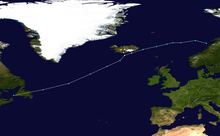 | |
| Date of impact | 4–6 December |
| Maximum wind gust | 81 mph (130 km/h; 70 kn) (Capel Curig, Conwy) |
| Lowest pressure | 939 hPa (27.7 inHg) |
| Fatalities | 3 |
| Power outages | 46,300 |
| Damage | ≥ £870 million (≥ €970 million) |
Desmond was the fourth storm to be officially named, with heavy rain and severe gales forecast for 5–6 December across Ireland and the north of the UK. On 4 December, the Met Office issued yellow warnings for wind and rain across most of the north of the UK and an amber warning for rain in parts of central and southern Scotland, Tayside and Fife Met Éireann issued a status red rainfall warning for areas of Connacht, as well as counties Donegal, Clare and Kerry, with Clare County Council issuing a flood warning.
On 5 December, the Met Office issued a red severe weather warning for rain in Cumbria. The Environment Agency had severe flood warnings in place for parts of the River Tyne in Northumberland and across Cumbria.
The expected heavy rainfall was considered to be an extreme weather event by the Norwegian Meteorological Institute, who named it Synne. The US National Weather Service Ocean Prediction Center tweeted that the heavy rain was due to Desmond pulling a plume of moist air across the Atlantic Ocean to Western Europe, a weather phenomenon known as an atmospheric river.
Approximately 1,000 people were evacuated from their homes in Hawick, Scottish Borders on 5 December, because the River Teviot flooded. Appleby and Keswick in the English county of Cumbria suffered blocked roads and some homes were evacuated; Cumbria Police declared the situation a "major incident". Homes left without electricity occurred in North Yorkshire (over 600) and in Wales (about 700); a further 2,000 people were without power in the Republic of Ireland. Landslides and flooding closed some main roads in Scotland and counties Down and Tyrone suffered road closures from fallen trees.
Storm Eva
Main article: Storm Eva| Eva | |
|---|---|
 MODIS image of Eva on 23 December 2015 MODIS image of Eva on 23 December 2015 | |
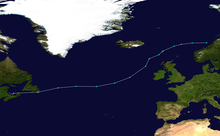 | |
| Date of impact | 23–24 December |
| Maximum wind gust | 84 mph (135 km/h; 73 kn) (Belmullet, County Mayo) |
| Lowest pressure | 964 hPa (28.5 inHg) |
| Fatalities | 0 |
| Power outages | 3,000 |
| Damage | ≥ £2.0 billion (≥ €2.2 billion) |
Eva was the fifth storm to be officially named by Met Éireann on 22 December 2015, with an orange wind warning being issued for counties Clare, Galway, Mayo, Sligo and Donegal. Gales were also expected in the northwest of the UK, with storm force winds over parts of the Outer Hebrides. There were fears that the storm could cause further disruption to Cumbria in England, where areas were already dealing with the aftermath of flooding from Storm Desmond and in some cases had been flooded twice already. The army and Environment Agency staff were called in to be on stand-by to bolster flood defences.
Rain associated with the passage of Eva caused further disruption when rivers burst their banks in the Cumbrian towns of Appleby, Keswick and Kendal on 22 December, with Appleby receiving three to four feet of flood water. The village of Glenridding was badly flooded for the third time in the month. 6000 houses in Ireland were left without power. Liz Truss convened a COBRA meeting to decide on emergency measures, which included the deployment of soldiers from the 2nd Battalion, Duke of Lancaster's Regiment to the affected areas. On 24 December, flood defence gates were closed in Carlisle, Keswick and Cockermouth to limit the damage of rainfall and 20 water pumps and two kilometres of temporary flood barriers were transported to northern England. Ferries operating between Dublin and Holyhead were cancelled due to bad weather on the Irish Sea.
The media widely reported Storm Eva as being responsible for the flooding which occurred in Lancashire and Yorkshire on 25–27 December 2015. However, communications from the Met Office indicated that Eva's only direct impact on the UK was strong winds and a band of rain during 23–24 December 2015. By 26 December Storm Eva was located over the far north of Norway. The persistent heavy rain from 25 to 27 December was caused by a subsequent slow moving depression and frontal zone. Despite red warnings for rain being issued by the Met Office on 26 December 2015, no name was given to this depression since there were no warnings issued for wind.
Storm Frank
Frank was the sixth storm to be officially named by the Met Office on 28 December 2015, and brought severe gales to western parts of the UK as well as persistent, heavy rainfall. It caused some disruption over Northern Ireland, west and southwest Scotland, northwest England and Wales on 30 December. Amber 'be prepared' rainfall warnings, meaning "danger to life," had been issued because of severe flooding reported in England and Scotland.
In Scotland, Frank caused floods in the towns of Dumfries, Peebles and Ballater flooded by the rivers Nith, Tweed and Dee.
The storm claimed three casualties across Cornwall, Moray and the Highlands.
The Free University of Berlin named the storm Eckard.
Storm Gertrude
| Gertrude | |
|---|---|
 MODIS image of Gertrude on 29 January 2016 MODIS image of Gertrude on 29 January 2016 | |
 | |
| Date of impact | 29 January |
| Maximum wind gust | 105 mph (169 km/h; 91 kn) (Lerwick, Shetland Islands) |
| Lowest pressure | 948 hPa (28.0 inHg) |
| Fatalities | 0 |
| Power outages | 10,000 |
| Damage | ≥ £80 million (≥ €90 million) |
On 28 January, the Met Office released news of the seventh named storm, Gertrude. In the release, they forecast a deepening area of low pressure to pass close to the north of Scotland on the night of 29 January, accompanied by a powerful jet stream from the Atlantic. It was anticipated that Scotland and Northern England would experience gales or severe gales (60–70 mph widely; possible 80 mph ) with the Northern Isles "likely" to reach storm force winds (widely 70–80 mph , occasionally 90 mph ). They warned of impacts to transport, power supplies and structural damage. The extent of amber severe weather warnings spread across the Northern Isles, western and southern Scotland and the "far north" of England and Northern Ireland. The winds for the early morning of 29 January were forecast to widely reach 60–70 mph (97–113 km/h; 52–61 kn) and perhaps 80 mph (130 km/h; 70 kn) in places. The Met Office noted other hazards such as large waves on western coasts and surface water from heavy rain during the morning.
Winds were expected to strengthen and create the risk of blizzard conditions, especially over high ground in the north of Scotland. The Chief Operational Meteorologist said: "There remains some uncertainty over the exact track and intensity of the storm", however there was "higher confidence now" on the forecast of very strong winds and storm force winds in the Northern Isles. Press releases from Transport NI and Scotland's Transport Minister, Derek Mackay, reaffirmed the risk of strong winds and advised people to take care during the course of the storm. At 09:03 on 29 January, the Met Office upgraded the warning to red over the Shetland Islands (between 12:00 and 16:00), with gusts of around 100 mph (160 km/h; 87 kn) expected and warned of very large waves.
Gertrude caused the closures or restrictions on some bridges (Erskine Bridge, Tay Road Bridge, Forth Road Bridge and Severn Bridge) during the storm. On 29 January, 10% of Abellio ScotRail services were cancelled. There were also power cuts across Scotland and Northern Ireland.
Storm Henry
On 30 January, the Met Office released news about the eighth named storm of the season, Henry. It was forecast to bring heavy rain and very strong gusts of wind across Scotland, northern England and northern Wales on 1–2 February, particularly into the night of 1 February. It was anticipated to bring gales across north Wales and north England, and severe gales across Scotland, most notably in the western isles, which was expected to bring gusts of up to 90 mph (140 km/h; 78 kn), resulting in amber wind warnings being issued. Localised flooding, transport disruption and issues with power supplies were expected, along with storm large waves being an additional concern.
Storm Imogen
| Imogen | |
|---|---|
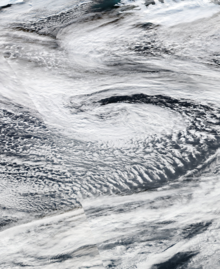 MODIS image of Imogen on 7 February 2016 MODIS image of Imogen on 7 February 2016 | |
| Date of impact | 7–8 February |
| Maximum wind gust | 96 mph (154 km/h; 83 kn) The Needles Old Battery, Isle of Wight |
| Lowest pressure | 962 hPa (28.4 inHg) |
| Fatalities | 0 |
| Power outages | 19,000 |
| Damage | ≥ £80 million (≥ €90 million) |
On 6 February Met Éireann issued an amber warning for strong winds and named Storm Imogen. At this stage the Met Office had issued a yellow warning for strong winds in south-west England and South Wales. On 7 February, the Met Office yellow warning area was enlarged and an amber warning added for winds across south-western England of 60–70 mph (97–113 km/h; 52–61 kn) and locally 80 mph (130 km/h; 70 kn) on 8 February. They warned of the risk to trees, structures, interruption of power supplies and transport, especially the M4 and M5 motorways. On 8 February Storm Imogen brought trees down, produced large coastal waves, caused power cuts and toppled high-sided vehicles across southern England and Wales.
Storm Jake
| Jake | |
|---|---|
 MODIS image of Jake on 2 March 2016 MODIS image of Jake on 2 March 2016 | |
| Date of impact | 2 March |
| Maximum wind gust | 83 mph (134 km/h; 72 kn), Mace Head |
| Lowest pressure | 989 hPa (29.2 inHg) |
| Fatalities | 0 |
| Power outages | 8,240 |
| Damage | Unknown |
Jake was named by Met Éireann on 1 March based on an amber warning of strong winds for counties Galway, Mayo, Clare, Cork, Kerry and Limerick. Strong winds were experienced in much of the Republic of Ireland and also Wales and south-west England on 2 March. There were power cuts and trees blown down in parts of Wales. Disruption was also experienced in parts of south-west England.
Storm Katie
| Katie | |
|---|---|
 IR image of Storm Katie developing to the SW of England on 28 March 2016 IR image of Storm Katie developing to the SW of England on 28 March 2016 | |
| Date of impact | 28 March |
| Maximum wind gust | 106 mph (171 km/h; 92 kn) The Needles Old Battery, Isle of Wight |
| Lowest pressure | 971 hPa (28.67 inHg) |
| Fatalities | 1 |
| Power outages | 100,000 |
| Damage | ≥ £80 million (≥ €90 million) |
Katie, the eleventh storm of the season, was named by the Met Office on Good Friday, 25 March. During the first half of Easter Monday, 28 March strong winds were experienced widely across southern England with coastal gusts of 70–80 mph (110–130 km/h; 61–70 kn) and inland gusts of 50–70 mph (80–113 km/h; 43–61 kn) in many places. The peak gust of 106 mph (171 km/h; 92 kn) was recorded at the exposed site of The Needles Old Battery. Impacts were widespread across southern England including trees felled, wall, fence and roof damage, scaffolding collapses, bridge closures, flights, ferries and train cancellations and power outages.
Season effects
This table lists all known windstorms that affected the UK and Ireland during 2015–2016. It includes their name, duration, peak recorded gust (excluding mountain stations), lowest pressure, areas affected, deaths, and damage totals from the two nations. All damage figures are in 2015 pounds sterling and euros. The season's first half was more notable for rainfall and flooding, similar to that seen during the 2013–2014 Atlantic winter storms in Europe, which brought the 2013–2014 United Kingdom winter floods.
| Storm | Dates active | Highest wind gust | Lowest pressure | Casualties | Damages | |||
|---|---|---|---|---|---|---|---|---|
| Abigail | 7 – 15 November | 84 mph (135 km/h; 73 kn) | 964 hPa (28.5 inHg) | 0 | Unknown | |||
| Barney | 16 – 18 November | 85 mph (137 km/h; 74 kn) | 980 hPa (29 inHg) | 0 | ≥ £179 million (≥ €198 million) | |||
| Clodagh | 26 – 30 November | 97 mph (156 km/h; 84 kn) | 968 hPa (28.6 inHg) | 0 | ≥ £8 million (≥ €9 million) | |||
| Desmond | 3 – 8 December | 81 mph (130 km/h; 70 kn) | 939 hPa (27.7 inHg) | 3 | ≥ £870 million (≥ €970 million) | |||
| Eva | 22 – 25 December | 84 mph (135 km/h; 73 kn) | 964 hPa (28.5 inHg) | 0 | ≥ £2.0 billion (≥ €2.2 billion) | |||
| Frank | 28 – 31 December | 85 mph (137 km/h; 74 kn) | 928 hPa (27.4 inHg) | 3 | ≥ £280 million (≥ €310 million) | |||
| Gertrude | 29 January | 105 mph (169 km/h; 91 kn) | 948 hPa (28.0 inHg) | 0 | ≥ £80 million (≥ €90 million) | |||
| Henry | 1 – 2 February | 90 mph (140 km/h; 78 kn) | 944 hPa (27.9 inHg) | 0 | ≥ £80 million (≥ €90 million) | |||
| Imogen | 8 February | 96 mph (154 km/h; 83 kn) | 962.6 hPa (28.43 inHg) | 0 | ≥ £80 million (≥ €90 million) | |||
| Jake | 1 – 4 March | 83 mph (134 km/h; 72 kn) | 988.9 hPa (29.20 inHg) | 0 | Unknown | |||
| Katie | 25 – 28 March | 106 mph (171 km/h; 92 kn) | 971.0 hPa (28.67 inHg) | 1 | ≥ £80 million (≥ €90 million) | |||
| Season Aggregates | ||||||||
| 11 windstorms | 7 November – 28 March | 106 mph (171 km/h; 92 kn) | 928 hPa (27.4 inHg) | 7 | ≥ £3.657 billion (≥ €4.047 billion) | |||
Storms named by other European meteorological services
| 2015–16 Named storms table. |
|---|
|
See also
Notes
References
- ^ "Met Éireann and the UK Met Office release list of winter storm names". Met Éireann. 10–13 November 2015. Retrieved 13 November 2015.
- "Nigel and Steve among new storm names". BBC News. 20 October 2015. Retrieved 10 November 2015.
- "Met Éireann Weather Warning System Explained". Met Éireann. Retrieved 2 January 2016.
- When would we name a storm? (Video). The Met Office. 25 January 2016. Retrieved 29 January 2016.
- "Storm Abigail". Met Office. Archived from the original on 18 November 2015. Retrieved 17 November 2015.
- "Storm Barney". Met Office. Archived from the original on 22 November 2015. Retrieved 10 December 2015.
- "Storm Clodagh". Met Office. Archived from the original on 8 December 2015. Retrieved 1 December 2015.
- "Storm Desmond". Met Office. Archived from the original on 8 December 2015. Retrieved 4 December 2015.
- "Storm Eva". Met Office. Archived from the original on 24 December 2015. Retrieved 23 December 2015.
- ^ "UK Storm Centre". The Met Office. 8 January 2016. Archived from the original on 3 October 2016. Retrieved 13 January 2016.
- "Climatology and Observations Division Twitter page". Climatology and Observations Division. Met Éireann. Retrieved 14 January 2016.
- "UK Storm Centre: Abigail". Met Office. 16 November 2015. Archived from the original on 18 November 2015. Retrieved 17 November 2015.
- Ocean Prediction Center (2015). "East Atlantic Surface Analysis 00Z 13 November 2015". NOAA. Retrieved 17 November 2015.
- "Storm Abigail: All power supplies 'to be restored overnight'". BBC News. 13 November 2015. Retrieved 16 November 2015.
- ^ "Met Office officially names Abigail as first storm". Met Office. 10–12 November 2015. Retrieved 10 November 2015.
- "Analysis". Free University of Berlin. 11 November 2015. Retrieved 28 November 2015.
- "Storm Abigail: Weather warning upgraded to amber". BBC News. 11 November 2015. Retrieved 11 November 2015.
- Alastair Dalton (12–14 November 2015). "Schools shut, ferries cancelled by Storm Abigail". The Scotsman. Retrieved 12 November 2015.
- "Storm Abigail: First of Met Office's named storms to batter Scotland". BBC News. 10 November 2015. Retrieved 10 November 2015.
- "Storm Abigail: Schools to be closed and ferries cancelled". BBC News. 13 November 2015. Retrieved 13 November 2015.
- "Storm Abigail latest". SSE plc. 13 November 2015. Archived from the original on 17 November 2015. Retrieved 14 November 2015.
- "Climatology and Observations Division Twitter page". Climatology and Observations Division. Met Éireann. Retrieved 14 January 2016.
- "Storm Barney highest wind speeds". Met Office. 18 November 2015. Retrieved 18 November 2015.
- Ocean Prediction Center (2015). "East Atlantic Surface Analysis 12Z 17 November 2015". NOAA. Retrieved 17 November 2015.
- ^ "Storm Barney: Thousands still without power after 85mph winds". BBC News. 18 November 2015. Retrieved 18 November 2015.
- ^ "Global Catastrophe Recap - November 2015" (PDF). Aon Benfield Inc.
- "Storm Barney". Met Office. 16–17 November 2015. Retrieved 16 November 2015.
- "Barney Warning". BBC News. 16–18 November 2015. Retrieved 16 November 2015.
- "Republic of Ireland: 15,000 homes still without power after storms". BBC News. 18 November 2015. Retrieved 18 November 2015.
- "Analysis". Free University of Berlin. 16 November 2015. Retrieved 28 November 2015.
- "Climatology and Observations Division Twitter page". Climatology and Observations Division. Met Éireann. Retrieved 14 January 2016.
- "November 2015". Met Office.
- Met Office (2015). "Met Office Analysis Chart for 06Z November 30, 2015". Met Office. Retrieved 30 November 2015.
- "Windy this weekend, but Storm Clodagh looks unlikely". Met Office. 28 November 2015. Retrieved 28 November 2015.
- Marianne Brandt (28 November 2015). "Stormen hedder Gorm" (in Danish). Danish Meteorological Institute. Archived from the original on 2 December 2015. Retrieved 28 November 2015.
- "Grusomme Gorm blev til orkan: Brager gennem Sjælland" (in Danish). Ekstrabladet. 29 November 2015. Retrieved 29 November 2015.
- "Storm Clodagh brings power cuts and difficult road conditions". The Irish Times. 29 November 2015.
- "29/11/15: Severe weather: Engineers working to restore power (18:30 update)". Archived from the original on 21 January 2016. Retrieved 7 December 2015.
- "Storm Clodagh". Met Office. 30 November 2015. Archived from the original on 8 December 2015. Retrieved 1 December 2015.
- "Climatology and Observations Division Twitter page". Climatology and Observations Division. Met Éireann. Retrieved 14 January 2016.
- "Wind and rain records for Storm Desmond". Met Office. 6 December 2015. Retrieved 6 December 2015.
- Erdman, Jon (6 December 2015). "Storm Desmond Lashes U.K., Ireland With Flooding, Winds Over 100 MPH; Taps Caribbean Moisture". Weather.com. Retrieved 6 December 2015.
- Ocean Prediction Center (2015). "East Atlantic Surface Analysis 00Z 5 December 2015". NOAA. Retrieved 30 December 2015.
- "Storm Desmond: Met Office warns of more heavy rain and gale-force winds as clean-up continues". Telegraph.co.uk. 8 December 2015.
- "Tyrone showband era star Ivan swept to his death in Storm Desmond floodwaters". BelfastTelegraph.co.uk.
- Will Metcalfe (5 December 2015). "Storm Desmond hits North East RECAP: Corbridge homes evacuated and 70mph winds batter region". nechronicle. Retrieved 6 December 2015.
- Daniel Milligan (5 December 2015). "Corbridge homes evacuated and 70mph winds batter region". ChronicleLive. Retrieved 5 December 2015.
- "Storm Desmond hits UK". BBC News. 5 December 2015. Retrieved 5 December 2015.
- "Floods, power outages and travel issues across Ireland". The Irish Times. 5 December 2015. Retrieved 5 December 2015.
- ^ "Global Catastrophe Recap - December 2015" (PDF). Aon Benfield Inc.
- "Storm Desmond". Met Office. 4 December 2015. Archived from the original on 8 December 2015. Retrieved 4 December 2015.
- "Storm Desmond to bring heavy rain and strong winds". BBC News. 4 December 2015. Retrieved 4 December 2015.
- "Status Red warning as Storm Desmond approaches". RTÉ News. 4 December 2015. Retrieved 4 December 2015.
- Dutton, Liam (5 December 2015). "Cumbria floods: when will the rain stop?". Channel 4 News. Retrieved 5 December 2015.
- "Storm Desmond results in a red severe weather warning for rain in Cumbria". Met Office. 5 December 2015. Retrieved 5 December 2015.
- "Fase C: Ekstremværet Synne er i gang" (in Norwegian). Norwegian Meteorological Institute. 4 December 2015. Retrieved 5 December 2015.
- @NWSOPC (5 December 2015). "CIRA layered PW helps visualize #AtmosphericRiver; easy to see AR stretching from the Caribbean to Ireland/UK! #GRPG" (Tweet). Retrieved 5 December 2015 – via Twitter.
- "Storm Desmond brings flooding and disruption to parts of UK". BBC News. 5 December 2015. Retrieved 5 December 2015.
- "Climatology and Observations Division Twitter page". Climatology and Observations Division. Met Éireann. Retrieved 14 January 2016.
- "#StormEva". Climatology and Observations Division. Met Eiriann. 8 January 2016. Retrieved 8 January 2016.
- Ocean Prediction Center (2015). "East Atlantic Surface Analysis 12Z 24 December 2015". NOAA. Retrieved 5 January 2016.
- "Floods latest: Boxing Day power cuts for thousands in Yorkshire". ITV News.
- "Storm Eva". Met Office. 22 December 2015. Archived from the original on 24 December 2015. Retrieved 23 December 2015.
- "Storm Eva brings fresh flooding fears for Cumbria". BBC News. 23 December 2015. Retrieved 23 December 2015.
- "Storm Eva: Cumbrians braced for further flood misery". ITV News. 24 December 2015. Retrieved 10 January 2016.
- Perring, Rebecca (24 December 2015). "Army on standby for flooding crisis as shock FIVE INCHES of rain to come with Storm Eva". Express.co.uk. Retrieved 10 January 2016.
- "Storm Eva brings fresh flooding fears for Cumbria". BBC News. 23 December 2015. Retrieved 24 December 2015.
- Glover, Mike (22 December 2015). "Further flooding worsens troubles for Cumbrian towns hit by Storm Desmond". The Guardian. Retrieved 24 December 2015.
- "Over 6,000 without power as Storm Eva hits". RTÉ.ie. 24 December 2015. Retrieved 10 January 2016.
- "Flood warnings as Britain is braced for torrential Boxing Day rain". Isle of Man Today. 29 December 2015. Retrieved 10 January 2016.
- "Storm Eva brings fresh flooding fears for Cumbria". BBC News. 23 December 2015. Retrieved 10 January 2016.
- "Flooded Cumbrian families are facing further misery on Christmas Day". The Independent. 23 December 2015. Archived from the original on 1 May 2022. Retrieved 10 January 2016.
- "Storm poses Christmas Day flooding threat for thousands of homes". Bradford Telegraph and Argus. Retrieved 10 January 2016.
- "Surface pressure chart 0000 UTC 26 December 2015". Met Office. 26 December 2015. Archived from the original on 4 March 2016. Retrieved 7 January 2016.
- "Storm Eva". Met Office. 23 December 2015. Archived from the original on 24 December 2015. Retrieved 7 January 2016.
- "Records smashed during mild, wet December". Met Office. 31 December 2015. Retrieved 7 January 2016.
- "Climatology and Observations Division Twitter page". Climatology and Observations Division. Met Éireann. Retrieved 14 January 2016.
- "Storm Frank". The Met Office. 30 December 2015. Archived from the original on 4 March 2016. Retrieved 31 December 2015.
- Ocean Prediction Center (2015). "East Atlantic Surface Analysis 06Z 30 December 2015". NOAA. Retrieved 5 January 2016.
- "Homes evacuated and power cuts as Storm Frank hits UK". BBC News. 31 December 2015. Retrieved 2 January 2016.
- "Storm Frank: NI hit by floods, power cuts and travel disruption". BBC News. 31 December 2015. Retrieved 2 January 2016.
- "Storm Frank to bring another spell of wet and windy weather". Met Office. 28 December 2015. Retrieved 28 December 2015.
- "Widespread flood warnings as UK braces for Storm Frank". The Guardian. 29 December 2015. Retrieved 31 December 2015.
- "After Storm Frank, Scotland rallies to fix itself amid the chaos". The Guardian. 1 January 2016. Retrieved 2 January 2016.
- "Storm Frank: second man dies in Scotland". The Guardian. 1 January 2016. Retrieved 2 January 2016.
- "Analysis". Free University of Berlin. 29 December 2015. Retrieved 29 December 2015.
- ^ "Storm Gertrude: Gales cause chaos across parts of UK". BBC News. 29 January 2016. Retrieved 29 January 2016.
- "Global Catastrophe Recap - January 2016" (PDF). Aon Benfield Inc.
- ^ "Storm Gertrude to bring strong winds to northern Britain". The Met Office. 28 January 2016. Retrieved 29 January 2016.
- "Warnings in place for the region: Orkney & Shetland". Met Office. 29 January 2016. Retrieved 29 January 2016.
- "Storm Gertrude: Gales cause chaos across parts of UK". BBC News. 29 January 2016. Retrieved 29 January 2016.
- @metofficestorms (2 February 2016). "Selected peak wind gusts from #StormHenry (mph): S Uist 90, Benbecula 85, Malin Head 81, Salsburgh 78, Skye 77, Loftus 75, Glasgow 67" (Tweet) – via Twitter.
- "Rush hour travel warning as Storm Henry hits Scotland". BBC News. 2 February 2016. Retrieved 2 February 2016.
- ^ "Global Catastrophe Recap - February 2016" (PDF). Aon Benfield Inc.
- Turner, Camilla (30 January 2016). "UK weather: Storm Henry to batter Britain, Met Office warns". The Telegraph. Retrieved 30 January 2016.
- "Storm Imogen". Met Office. Archived from the original on 8 February 2016. Retrieved 8 February 2016.
- "Storm Imogen leaves homes without power across England and Wales". BBC News. 8 February 2016. Retrieved 8 February 2016.
- @metoffice (6 February 2016). "#StormImogen has just been named by our partners @MetEireann and will move across the UK during the course of Monday" (Tweet) – via Twitter.
- "Met Office names the UK's next storm". The Met Office. Retrieved 7 February 2016.
- "Power being restored after Storm Imogen hits England and Wales". BBC. Retrieved 1 April 2016.
- "Storm Jake: Wind causes fallen trees and power cuts". BBC. Retrieved 1 April 2016.
- "STORM JAKE: Bad day to be a tree, hailstorm havoc, bin day blues at Southway". Plymouth Herald. Archived from the original on 4 March 2016. Retrieved 1 April 2016.
- "Storm Katie". Met Office. 28 March 2016. Retrieved 29 March 2016.
- ^ "Global Catastrophe Recap - March 2016" (PDF). Aon Benfield Inc.
- "Storm Katie to arrive on Easter Monday". Met Office. Retrieved 1 April 2016.
- Ramsdale, Steven; Kelly, Jason (April 2018). ""Storm Katie"- Rapid cyclogenesis and damaging winds of Easter Monday 2016". Weather. 73 (4): 103–109. Bibcode:2018Wthr...73..103R. doi:10.1002/wea.2986. S2CID 126085776.
- "Storm Katie: Flights cancelled and property damaged". BBC. Retrieved 1 April 2016.
- "Storm Katie: High winds cause damage across London". BBC. Retrieved 1 April 2016.
- "Storm Katie round-up". BBC. Retrieved 1 April 2016.
- "Your pictures: Storm Katie destruction across the UK". BBC. Retrieved 1 April 2016.
- Ramsdale, Steven; Kelly, Jason (22 September 2017). "Storm Katie – Rapid cyclogenesis and damaging winds of Easter Monday 2016". Weather. 73 (4): 103–109. Bibcode:2018Wthr...73..103R. doi:10.1002/wea.2986. S2CID 126085776.
External links
- "Storm Abigail - Ireland and UK's first officially named storm". EUMETSAT. Archived from the original on 20 November 2015.
| European windstorm seasons | |
|---|---|
| UK and Ireland windstorm seasons (2015–2017) | |
| European windstorm seasons (2017–) | |
| Notable storms |
|


